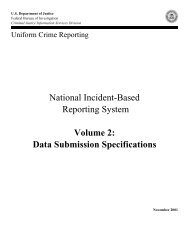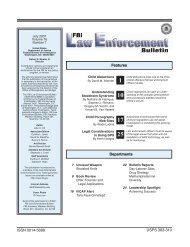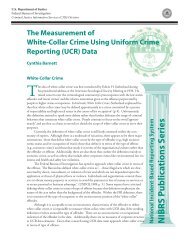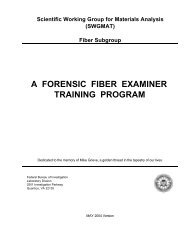F B I Law Enforcement Bulletin - June 2003 Issue
F B I Law Enforcement Bulletin - June 2003 Issue
F B I Law Enforcement Bulletin - June 2003 Issue
Create successful ePaper yourself
Turn your PDF publications into a flip-book with our unique Google optimized e-Paper software.
does the psychological profile say about high manipulation<br />
or violence potential? Are there any past<br />
incarcerations in other state or federal prisons?<br />
Corrections officers should find out as much as<br />
possible about the criminals they face daily.<br />
Likewise, law enforcement officers should apply<br />
these same techniques. If career criminals reside<br />
within the community, officers<br />
should know who they are and<br />
what kind of danger they present.<br />
This illustrates the importance of<br />
maintaining liaison with parole<br />
divisions, departments of corrections,<br />
and county jail facilities.<br />
These institutions can share<br />
important information about such<br />
criminals. Are they involved in<br />
multiple criminal activities, such<br />
as narcotics, armed robbery, and<br />
burglary? Are they spontaneous<br />
or methodical in their criminal<br />
activities? Do they have a history<br />
of high violence potential? Were<br />
they members of an STG while in prison? Answers<br />
to these types of questions can mean the difference<br />
between life and death for officers responding to calls<br />
for service, executing search warrants, or making<br />
traffic stops or other contacts, as illustrated dramatically<br />
by the opening scenario of this article.<br />
In short, to effectively curtail the activities of<br />
career criminals and the groups to which they often<br />
belong, criminal justice professionals must learn the<br />
mind-sets, traits, and characteristics of these offenders.<br />
Officers must know how and where to obtain<br />
information on these individuals. To this end, communicating<br />
this type of information between corrections<br />
and law enforcement personnel becomes paramount<br />
for the safety of both professional entities, as well as<br />
the communities they serve.<br />
Conclusion<br />
A growing trend seems to be developing among<br />
prison gangs to organize criminal street crews to<br />
facilitate the drug trade. The enormous profits available<br />
to those willing to take the risks inherent in this<br />
and other lucrative illegal enterprises are leading to a<br />
12 / FBI <strong>Law</strong> <strong>Enforcement</strong> <strong>Bulletin</strong><br />
“<br />
If career criminals<br />
reside within the<br />
community, officers<br />
should know who they<br />
are and what kind of<br />
danger they present.<br />
change in the way gangs do business. Other indications<br />
exist that imply increasing cooperation among<br />
criminal gangs.<br />
Current gang trends, while disturbing, are not<br />
unexpected when considering the history of gangs in<br />
America and in other countries. Historically, gang<br />
activity has flourished during those periods of time<br />
when sources of illegal profit<br />
were readily available and social<br />
conditions encouraged the<br />
existence of gangs. The entire<br />
criminal justice system needs to<br />
educate itself to combat this most<br />
recent form of organized criminal<br />
behavior and profit. The first<br />
important step in this process<br />
rests with an exchange of information<br />
between the law enforcement<br />
and corrections communi-<br />
”<br />
ties that will allow for the<br />
tracking of criminals as they<br />
increasingly migrate around the<br />
country. As the flow of information<br />
increases so will the effectiveness of combating<br />
such criminal activities. Although the criminal justice<br />
system never will stop all criminal activity, gang<br />
enforcement is an area where police and corrections,<br />
with increased intelligence information sharing, can<br />
make a major impact in reducing the interrelated<br />
threat posed by career criminals, security threat<br />
groups, and prison gangs.<br />
Endnotes<br />
1 The authors based this article on a research project they participated<br />
in that compiled information about gangs obtained from personal<br />
interviews with local, state, and federal police officers, as well as officers<br />
working in local, state, and federal correctional institutions.<br />
2 For additional information, see Mike Langston, “Addressing the<br />
Need for a Uniform Definition of Gang-Involved Crime,” FBI <strong>Law</strong><br />
<strong>Enforcement</strong> <strong>Bulletin</strong>, February <strong>2003</strong>, 7-11.<br />
3 U.S. Department of Justice, Federal Bureau of Investigation, An<br />
Introduction to Violent Street Gangs in the United States, 2nd edition,<br />
1999.<br />
4 FBI analyst, Safe Streets Gang Unit.<br />
5 The authors’ education results from their personal interactions with<br />
career criminals, security threat groups, and gang members during their<br />
many years of working in the criminal justice system.<br />
6 For additional information on gang structure, see David M. Allender,<br />
“Gangs in Middle America: Are They a Threat?” FBI <strong>Law</strong> <strong>Enforcement</strong><br />
<strong>Bulletin</strong>, December 2001, 1-9.














